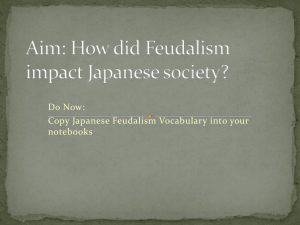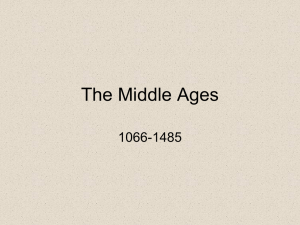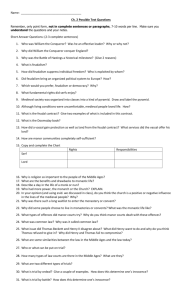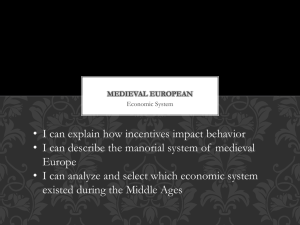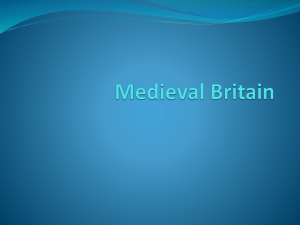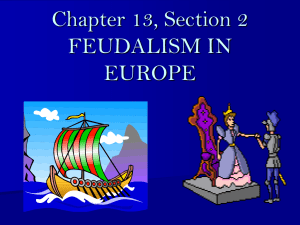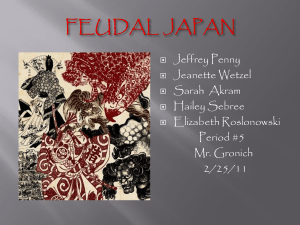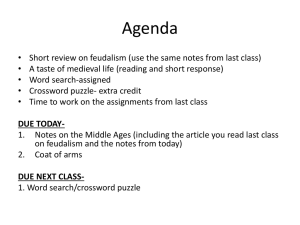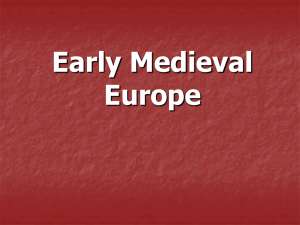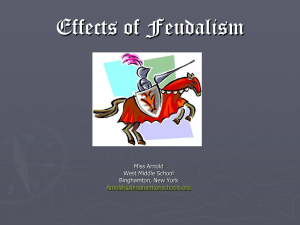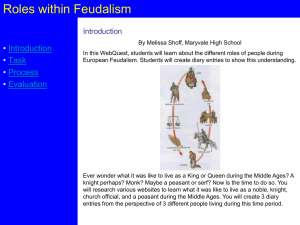Medieval History - Ms. Meeks English IV Honors Period 3
advertisement
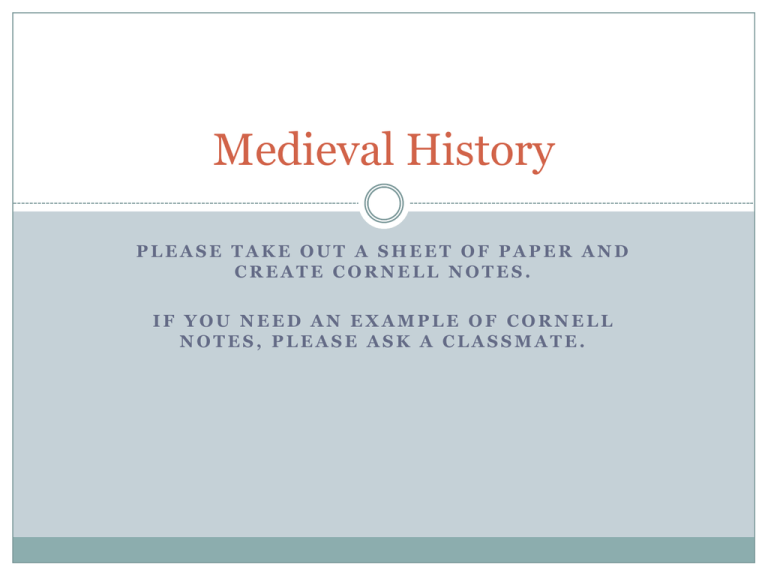
Medieval History PLEASE TAKE OUT A SHEET OF PAPER AND CREATE CORNELL NOTES. IF YOU NEED AN EXAMPLE OF CORNELL NOTES, PLEASE ASK A CLASSMATE. The Beginnings The Middle Ages or medieval period in England began with the Norman Conquest in 1066. William, duke of Normandy, invaded England in 1066 believing he was the rightful heir to the English throne. He became known as William the Conqueror and ruled over the Anglo-Saxon people. William made significant contributions to England: Domesday Book – an inventory of nearly every piece of property in England (i.e. land, cattle, buildings, etc.) Brought French influence in the English language and culture Brought a new social structure (feudalism) to England Feudalism and Knighthood: Pyramid Power A social system that also functioned as a caste system, property system, and military system in medieval England. Feudalism was developed on the religious concept that God was the supreme ruler and a hierarchy was constructed underneath Him. At the top of the feudal pyramid was God, followed by the Pope, and then the kings. Kings were believed to have a “divine right” to rule, meaning their power over the people was given to them directly by God. Feudalism continued… The king had the power to appoint barons as vassals and, as king, give each of the barons a portion of land in return for economic loyalty or military services. Vassals: a person granted the use of land, in return for rendering homage, loyalty to a leader, and usually military service or its equivalent to a lord or other superior; feudal tenant. In a sense, each person in the feudal system is a vassal (including the king) because each person is bound in a relationship with the power above him. The barons could then appoint vassals of their own for either economic loyalty or military services (and so on and so forth) The feudal system operated all the way down to the landless knights and to the serfs. Serf: peasants who were not free to leave the land they worked on Pyramid Power! Since I know you can’t get enough feudalism… Problems with feudalism: What do you notice about the bottom of the pyramid in relation to the top? The bottom is significantly larger, meaning there are more people in that social group than the one above it. A vassal (at any level) may choose to disobey a weak or tyrannical overlord, leading to uprisings at any level. For example, a baron, secure in his own castle with protection from his vassals, may choose to denounce or disobey the king. Other implications of feudalism: The feudal system also created strict social rules each member was expected to follow. Rules governed manners and daily life and influence the art and literature of the medieval period. Starting to think Ms. Fitz is a feudal lord here… Knighthood: Since the primary duty of males above the serf class was military service to their lords, boys ere trained from an early age to become warriors. Boys often lived in houses and completed their strict training in homes outside of their own families. Once their training was completed, boys became men with the title “sir” and were given the full rights and responsibilities of their place as a knight. Knighthood was based upon the feudal ideal of loyalty and therefore came with a strict set of social codes that could not be broken. Can you think of any examples of social systems that have the characteristics of feudalism today? Women in Medieval Society: No Voice, No Choice Women had no political rights in feudalism. A woman was always subservient to a man: Father, brother, husband Her father/brother/husband’s social standing determined her social standing and the amount of respect she was afforded. For peasant women, life was simply childbearing, housework, fieldwork (rinse and repeat!). For women of the upper-class, life was simply childbearing and household supervision (rinse and repeat!). These women may have some power, particularly when their fathers/brothers/husbands were away on business or war but this was only temporary. Chivalry and Courtly Love: Ideal but Unreal Chivalry – a system of ideals and social codes governing the behavior of knights and gentlewomen One of the most important codes of chivalry was the oath of loyalty to the overlord. This oath was essentially a promise to always protect and serve the leader. Another percept was never attacking an unarmed opponent in war. Courtly Love – the idea that revering and acting in the name of a lady (not necessarily one’s wife) would make a knight braver and better It is believed that the concept of courtly love stemmed from a religious cult of the Virgin Mary. Chivalry (we’re bringing it back!) In Courtly Love, a knight would choose a lady to “fight” for. He would wear his lady’s colors in battle, glorify her in words, and be inspired by her. Though the knight would profess his love for the lady, it was a nonsexual love that was NOT acted upon. A lady would remain untouched (as if on a pedestal) like the Virgin Mary Occasionally, courtly love provided built-in drama for poets and story-tellers, who told tales of those who have crossed the line between courtly love and physical love. For example, Sir Lancelot and Queen Guinevere’s relationship. Sir Lancelot broke both the chivalric code of loyalty to King Arthur and the code of courtly love. Courtly Love continued… Through courtly love and chivalric attitudes women became increasingly idealized. Women were believed to be weak and thought to “need rescuing” and support from a man. This attitude did little to help their social standing in life. A woman’s perceived value still remained tied to her husband and the value he owned in terms of land. Chivalry and courtly love also gave rise to the romance as a genre. Romance - a style of heroic prose and verse narrative that was popular in the aristocratic circles of the Middle Ages. Romances were fantastic stories about the marvelous adventures of a chivalrous, heroic knight, often of super-human ability, who often goes on a quest. Remember, fantastic = fantasy and marvelous = over the top Does the genre of romance remind you of anything we have studied? The New City Classes: Out from Under the Overlords In the Early Middle Ages, life centered around the feudal castle, but as the population increased people began to move into cities and towns. These cities and towns would eventually render the feudal system obsolete. In the cities, a new class system developed: Lower class Middle class Upper-middle class Peasants and nobles would still conform to the feudal system in the beginning With the development of cities and towns came the development of the merchant class. Merchant class did not conform to the stringent guidelines of feudalism Merchant class developed their own taste in art and had the ability to fund their wants and needs The Crusades (the war…not these notes) 1095-1270 The Crusades were a series of wars waged by European Christains against the Muslims. The two groups fought over the Holy Land (i.e. which group would occupy Jerusalem). The Crusades put the Europeans into contact with the higher civilization of the Middle East. Benefits included advancements in: Mathematics Astronomy Architecture Crafts In Chaucer’s The Canterbury Tales, the Knight mentions fighting in the Crusades and much of the rich and varied lifestyles we encounter in the poem (i.e. the Prioress) stem from contact with the Middle East via the Crusades. The Martyrdom of Thomas à Becket King Henry II appointed his friend Thomas Becket Archbishop of Canterbury hoping to be able to have more influence on the Pope. However, Becket did not allow that to happen. Thomas often sided with the Pope, which angered the King and in December 1170 King Henry is believed to have made a threatening remark about Becket. King Henry’s knights took him literally and murdered Becket in the church (gasp!). The public was outraged and this led to a cult surrounding Sir Thomas the Martyr and a backlash against the king. Thomas à Becket was later made a saint. In The Canterbury Tales, a group of people are traveling together to pay homage to Saint Thomas à Becket. Religious journey: pilgrimage The Magna Carta: Power to the People (sort of) Signed in 1215 by King John English barons forced the king to sign this document The Magna Carta listed basic rights that would be granted and guarenteed to “all” (“all” meaning all aristocratic citizens) The document symbolized the beginning of England’s break from papal (relating to the Pope) power. The document also brought feudalism to an end. Despite the fact that the English barons were not originally concerned with the “common people”, the Magna Carta, today, stands as the foundation for English constitutional law Rights such as trial by jury and legislative taxation were established. The Hundred Years’ War (Betchya can’t guess how long it lasted…) 1337-1453 The Hundred Years’ was waged between England and France and was fought mainly on French soil. The war began over which English king (Edward III and Henry V) was the legitimate heir to the French throne). This war was militarily unsuccessful for the English, but successful in creating a social consciousness (a.k.a. the English had a new way of thinking of themselves and an instilled sense of national pride. Militarily unsuccessful because it was the small landowners not the knights protecting the land. The Hundred Years’ War symbolized a major change in England – from knights in shining armor to the small landowners (this was the end of feudalism). The Black Death 1348-1349 The Black Death, also known as the Bubonic Plague, was highly contagious. The Black Death was caused by a bacteria and was spread through fleas and rats that came in contact with humans. The Black Death killed over 1/3 of Europe’s population. Hygiene was not a top priority in the Middle Ages: People took full baths about once a month. People did wash their hands, feet, and face and brush their teeth daily (if they could) No indoor plumbing; chamber pots were used and often dumped in such common locations as streets, waterways, or “dung piles” located outside of the cities. In public, a ditch was a toilet. Living space was cramped in cities, therefore disease traveled quickly When times were hard, people moved which contributed to the spread of diseases. The Black Death also contributed to the end of feudalism as the lower classes were able to gain leverage against the feudal lords. Symptoms: swollen lymph glands (commonly found in the armpits or neck) that eventually ooze pus (yuck!), fever, headaches, chills, nausea, and vomiting. The Black Death Medieval Architecture - Siena Medieval Architecture - Siena
